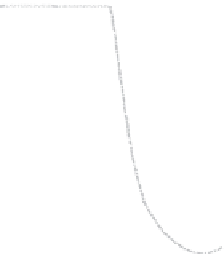Environmental Engineering Reference
In-Depth Information
of the drive train and the power converter limits. Care would also need to be taken
that the rotor speed did not decrease so much that the aerodynamic efficiency was
critically affected. Following the system transient,
H
gen
and hence the magnitude of
D
T
could be reduced, allowing the rotor speed to recover gradually. Indeed, by
introducing a compensation element the inertial response can be shaped as
required, maximising the system benefit, while minimising the impact on the wind
turbine itself (Holdsworth
et al.
, 2004).
DFIGs provide limited variable-speed capability, and thus offer some of the
advantages of full variable-speed designs. As discussed in Section 3.6.1, the stator
windings of the induction generator are connected directly to the power system,
while the rotor windings are fed via an AC-DC-AC converter to provide a variable
frequency supply. The generator (and turbine rotor) is thus partially decoupled from
the power system, with the result that the natural provision of an inertial response
will depend on a number of factors - these include current wind speed, wind turbine
aerodynamic mapping, stall versus pitch power regulation and torque control system
speed of response (SEI, 2004). Of these factors, the torque control loop is dominant
and so a DFIG machine will not naturally provide an inertial response. However, it is
clear that in a manner similar to full-variable speed machines, it can be introduced
artificially by modifying the torque setpoint as outlined earlier.
Various turbine manufacturers have proposed and/or developed emulated
inertia schemes (Ruttledge
et al.
, 2012), although only a very few power systems,
such as Hydro Quebec, require or incentivise such behaviour. It may, therefore, be
expected that with increased wind penetration, mainly in the form of such variable-
speed machines, conventional generation will be displaced, leading to a reduction
in the system inertia and stored energy. For smaller power systems, where the
system inertia is comparatively low and individual infeeds may supply a significant
fraction of the load demand, any reduction in system inertia will lead to a more
dynamic power system, with higher rates of change of frequency and greater fre-
quency dips (Lalor
et al.
, 2004). This is particularly true during periods of low
50
Fixed-speed IG
Variable-speed DFIG
49.8
49.6
49.4
49.2
49
0
4
8
12
16
20
Time (s)
Figure 5.34
DFIG versus fixed-speed turbine inertial response


































































Search WWH ::

Custom Search